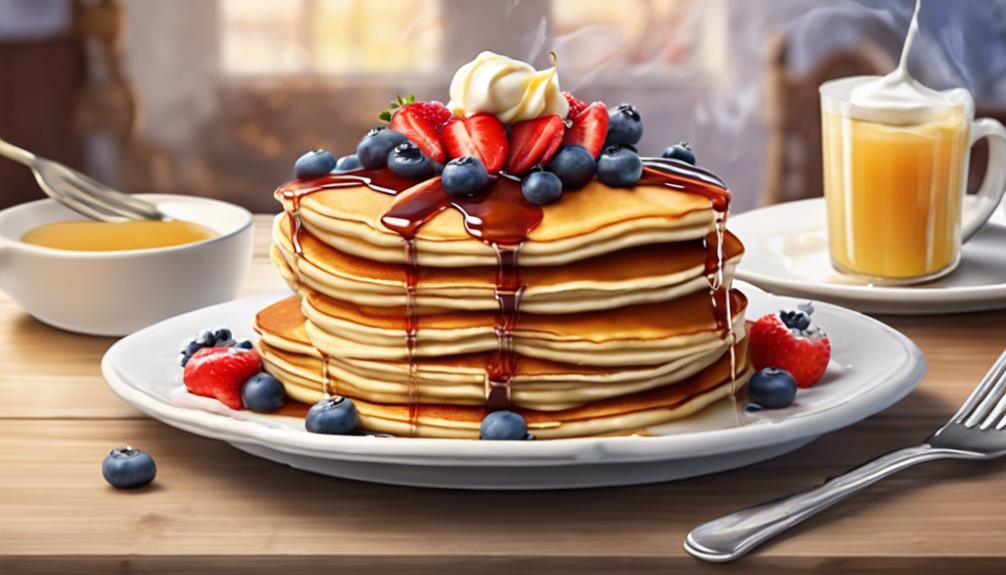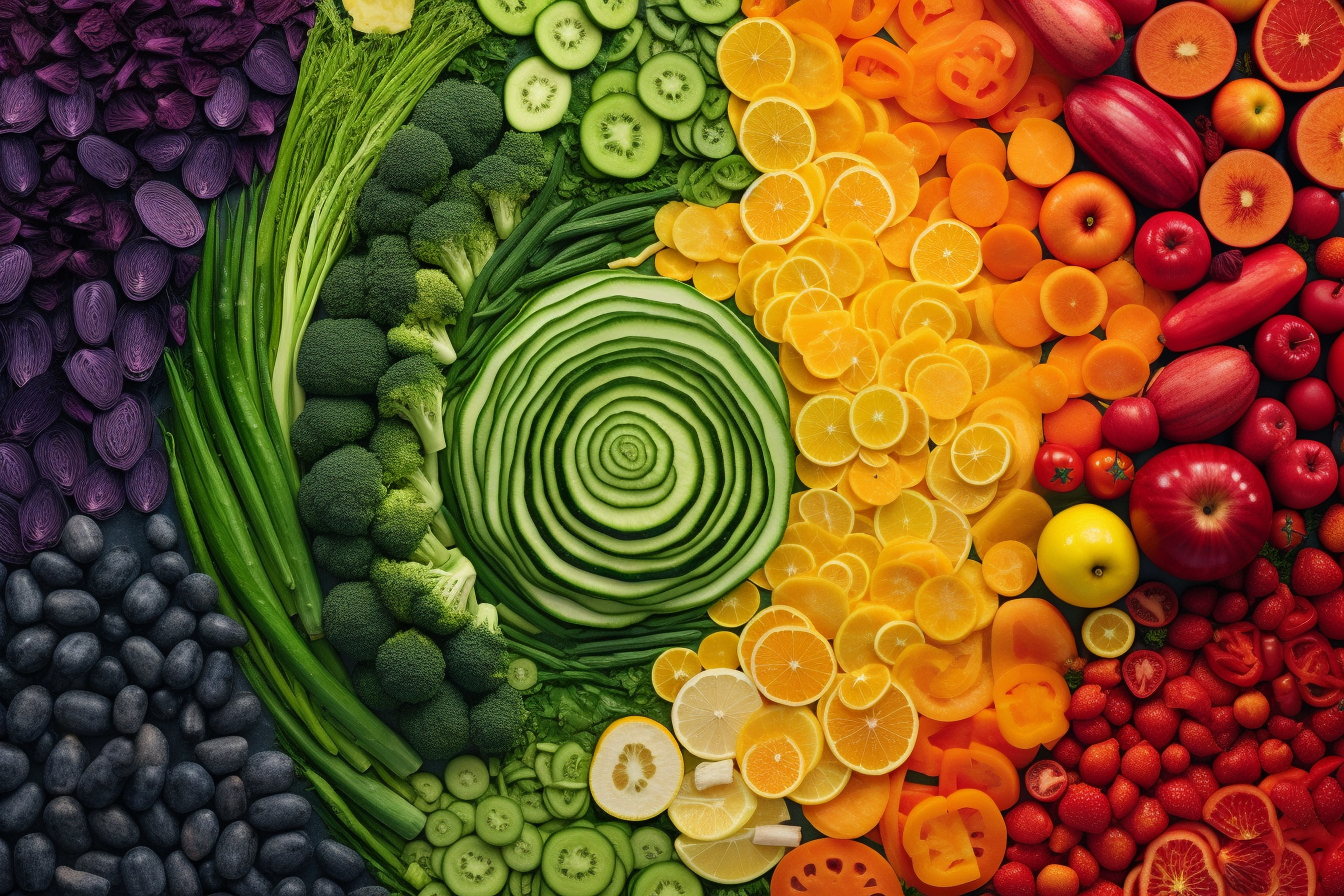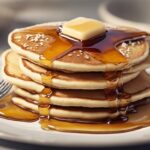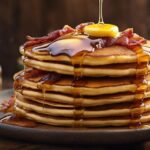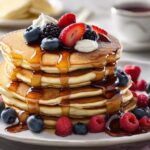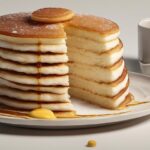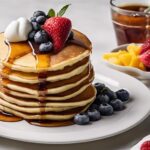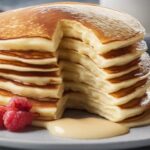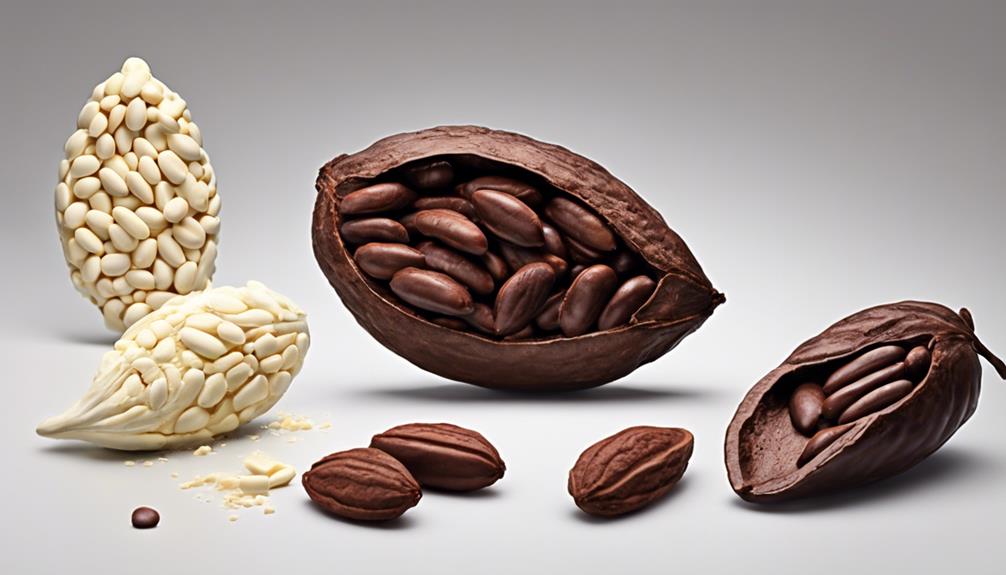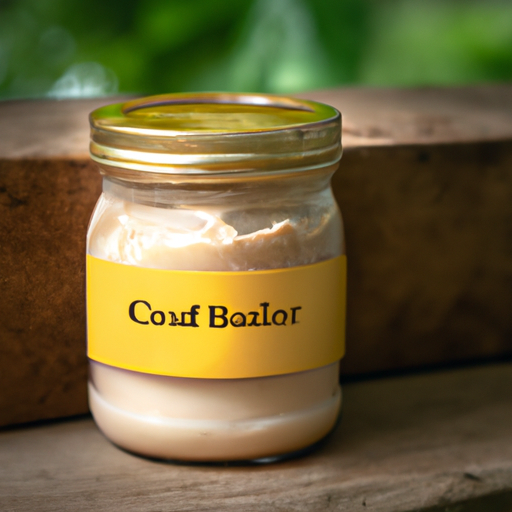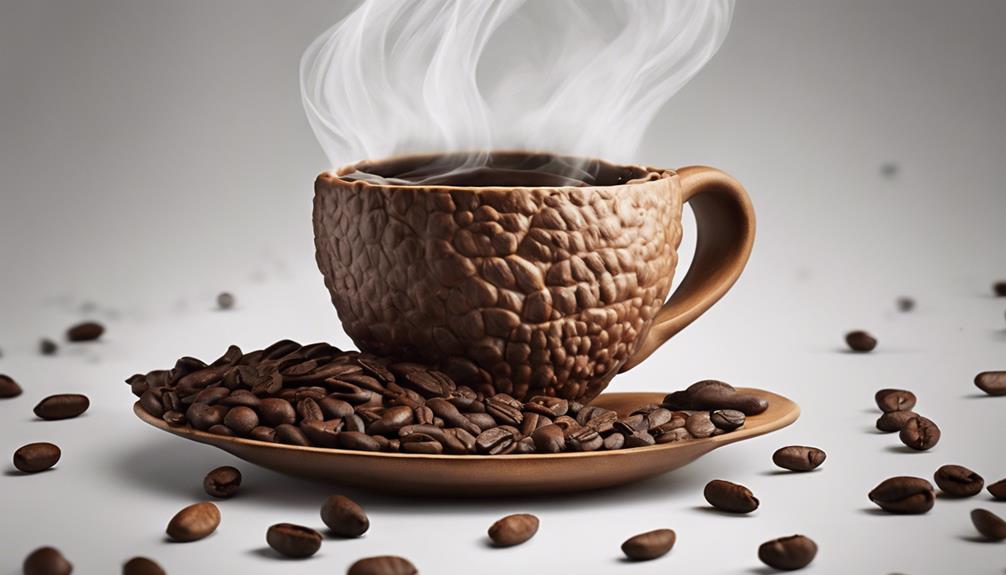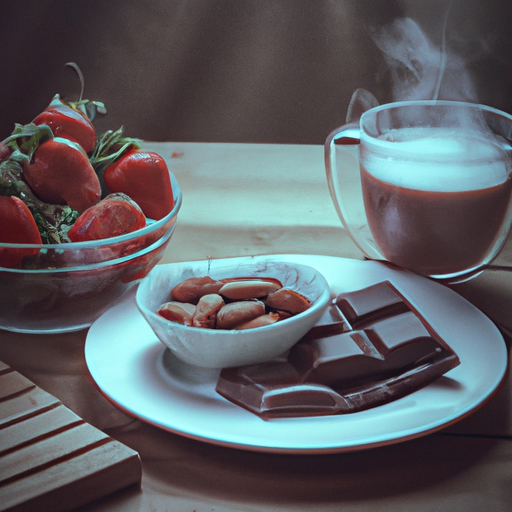When comparing hot cakes and pancakes, it is important to consider various factors in order to understand the differences between them. The historical origins of hotcakes and pancakes can be traced back to different cultural backgrounds, with pancakes being more popular worldwide. Global variations demonstrate diverse preferences, ranging from thick and airy Japanese hotcakes to tangy buttermilk pancakes in the US. Traditions like Pancake Day and events such as the Olney Pancake Race in England showcase the cultural significance of pancakes. Evolving breakfast trends and the influence of social media also contribute to the popularity of both hotcakes and pancakes. Iconic brands like McDonald’s and IHOP offer their own unique interpretations of these breakfast treats.
Japanese distinctions add to the complexity, with hotcakes being sweeter and fluffier compared to traditional pancakes. Notable achievements in the pancake world and the variety of regional styles all contribute to the rich tapestry of hotcakes and pancakes. Different cooking techniques and ingredients also shape the final outcome, making each bite a delightful experience. Are you curious to learn more about the differences between hotcakes and pancakes?
Key Takeaways
- Hotcakes are associated with quick sales and marketing.
- Pancakes have a longer history and are more prevalent.
- Hotcakes offer a thicker and fluffier alternative.
- Pancakes remain a staple in many cultures.
- Cultural influences globally shape perceptions of hotcakes and pancakes.
Historical Origins
Hotcakes and pancakes, though often used interchangeably, hold distinct historical origins that trace back to ancient civilizations like the Romans. While the term 'hotcakes' is commonly associated with quick sales and marketing strategies, 'pancakes' have a longer history and are more prevalent in everyday language. The Romans had their own version of sweet pancakes, showcasing the ancient roots of this beloved breakfast item. The term 'hotcakes' is often used by establishments like McDonald's to promote their pancake offerings, emphasizing the idea of fast-moving and popular products.
The evolution of pancakes throughout history has contributed to their widespread popularity today. From the ancient Roman times to modern-day breakfast tables, pancakes have remained a staple in many cultures worldwide. Understanding the historical significance of pancakes can provide insight into how this simple yet delicious dish has transcended time and boundaries, becoming a cherished meal enjoyed by people of all ages.
Global Variations
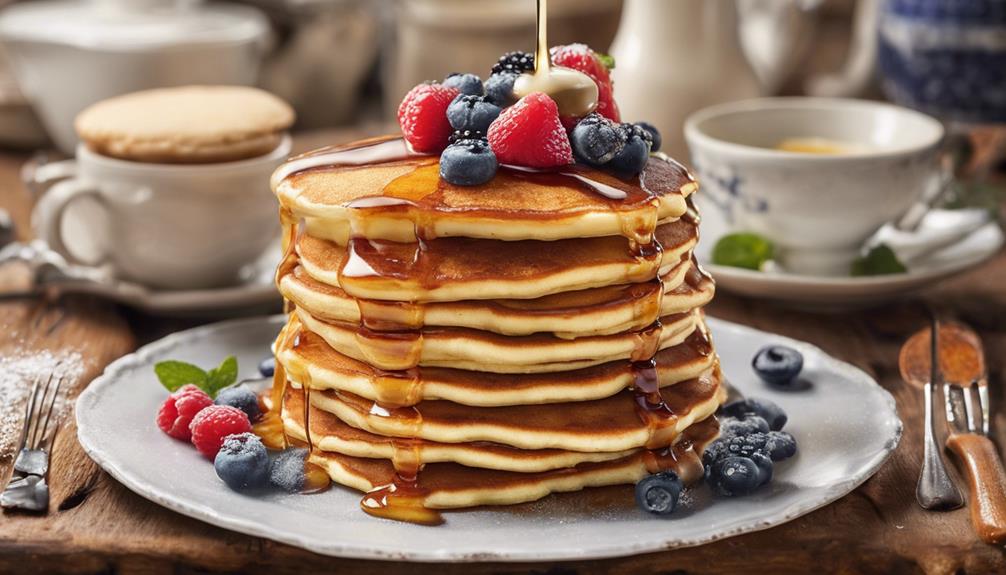
Exploring global variations in pancake preparations reveals a diverse array of flavors and textures influenced by regional culinary traditions. From Japanese hotcakes to American buttermilk pancakes, each culture puts its unique spin on this beloved dish. Here are some intriguing differences to contemplate:
- Japanese hotcakes are renowned for their exceptional thickness and airy texture, achieved by vigorously beating the batter until foamy.
- Buttermilk pancakes in the US are cherished for their tangy taste and fluffy consistency, showcasing a distinct regional flair.
- Cornmeal pancakes offer a slightly gritty mouthfeel and nutty flavor, presenting yet another interesting twist on the classic pancake.
- Toppings for pancakes vary widely, ranging from traditional choices like butter and maple syrup to more adventurous options such as bacon, cheese, or fruit compote.
- Elevate your pancake experience by experimenting with toppings like fresh fruit, chocolate sauce, nuts, or even a fried egg, enhancing the flavor profile of both hotcakes and pancakes.
Traditions and Events
Pancake Day, a traditional event celebrated on Shrove Tuesday before Lent, holds a special place in many cultures worldwide. On this day, people gather to enjoy stacks of delicious pancakes made with sugar, fats, and eggs before the Lenten season begins.
One fascinating tradition linked to Pancake Day is the annual Pancake Race held in Olney, England, dating back to 1445. This unique race, where participants run while flipping pancakes in a frying pan, is an exciting event that showcases the community's spirit and love for pancakes.
Another interesting aspect of Pancake Day is the friendly competition between Olney, England, and Liberal, Kansas, in an international Pancake Race. Over the years, Liberal has emerged victorious in this fun-filled event, boasting 37 wins compared to Olney's 29. These races not only celebrate the joy of pancake making but also foster camaraderie between different communities around the world.
Evolution of Popularity
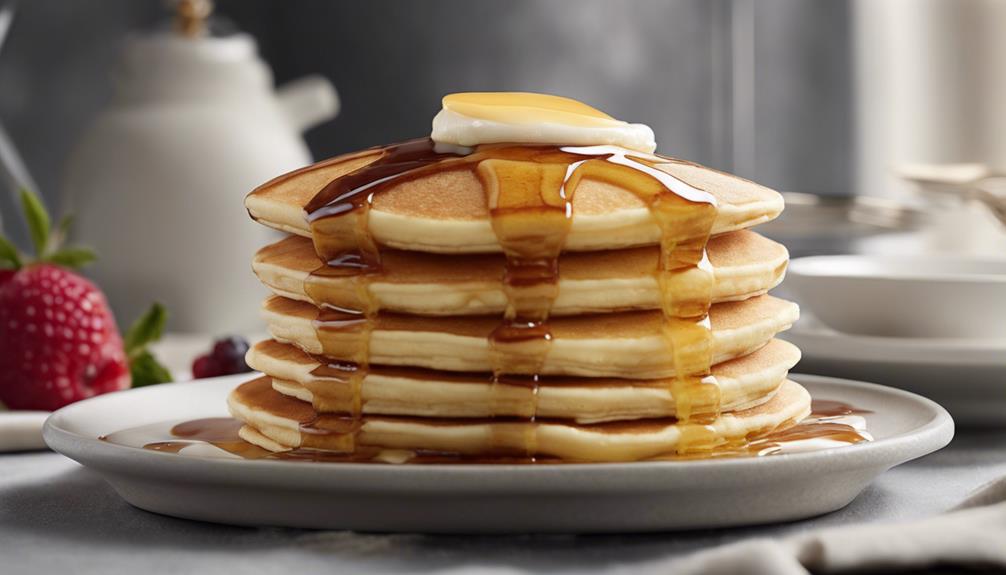
When considering the evolution of popularity between hot cakes and pancakes, it's imperative to explore:
- Trending breakfast options
- The influence of social media
- The cultural shifts in food preferences
These factors play a significant role in shaping the choices people make when it comes to their morning meals. By understanding these elements, we can gain insights into why certain breakfast foods gain traction while others may decline in popularity.
Trending Breakfast Options
In the domain of breakfast choices, the rise in popularity of hotcakes has markedly changed the landscape of morning dining preferences. Hotcakes have added a new dimension to the breakfast scene by offering a thicker and fluffier alternative to traditional pancakes.
Here are some key points to ponder:
- Hotcakes provide a unique twist on the classic pancake, appealing to those seeking a more indulgent breakfast experience.
- Specialty cafes and brunch spots have started featuring hotcakes, catering to the demand for innovative and Instagram-worthy dishes.
- Breakfast enthusiasts are drawn to hotcakes for their decadent toppings, creative presentations, and unique flavor combinations.
- The trend of hotcakes showcases how culinary traditions like pancakes can evolve to meet modern tastes and preferences.
- Hotcakes have become a trendy breakfast option, demonstrating the dynamic nature of morning meal choices.
Social Media Influence
With the rise of social media platforms like Instagram and TikTok, hotcakes and pancakes have experienced a resurgence in popularity driven by influencers and food bloggers showcasing elaborate creations. Social media has become a hub for sharing mouth-watering images of rainbow-colored hotcakes and intricate pancake art, sparking viral trends.
Hashtags such as #hotcakes and #pancakes boast millions of posts, highlighting their strong presence on social media. Users actively engage by sharing recipes, tips, and reviews, contributing to the ongoing evolution and popularity of hotcakes and pancakes.
The creative variations and innovative ideas circulating on platforms like Instagram and TikTok have transformed these breakfast classics into trendy food items, making them a must-try for food enthusiasts looking to explore new culinary delights.
Cultural Shifts in Food
Exploring the changing landscape of food culture reveals intriguing shifts in the popularity and perception of traditional dishes like hotcakes and pancakes.
- Pancake Mix: Aunt Jemima pancake mix was a significant development in pancake history, offering convenience and consistency.
- Evolution of Toppings: Pancakes are now enjoyed with a myriad of toppings, from classic maple syrup to innovative fruit compotes.
- Pancake Races: Events like the annual Pancake Race in Olney, England, dating back to 1445, showcase the enduring cultural appeal of pancakes.
- Shrove Tuesday Tradition: Pancake Day, celebrated before Lent, highlights the historical significance and cultural practices associated with pancakes.
- Vogue's Shift: Once criticized in 1935, pancakes are now celebrated, with Vogue offering online pancake recipes, reflecting a broader cultural shift in perception.
Iconic Brands
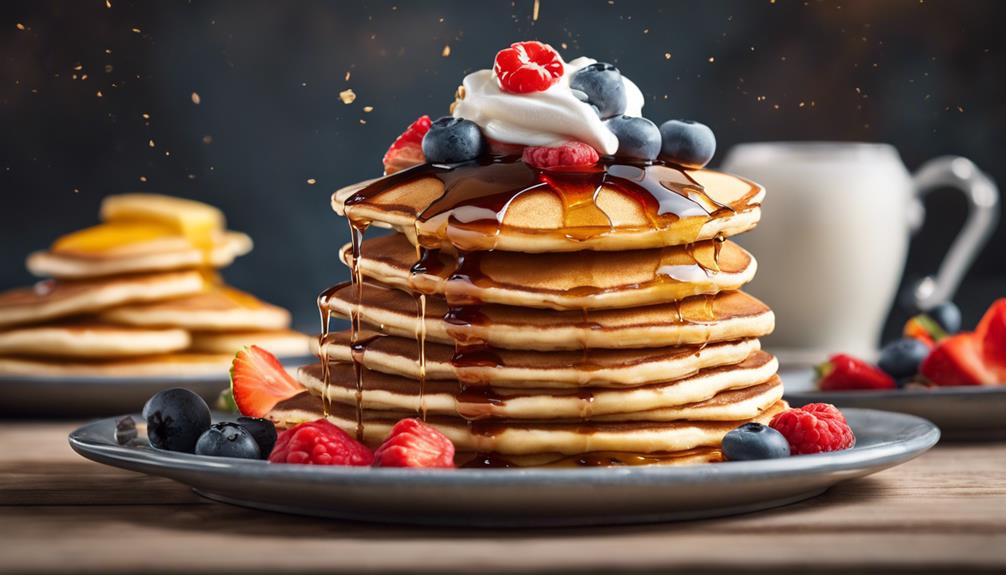
McDonald's iconic brand stands out with its distinctive hotcakes on the menu, setting them apart from traditional pancakes. While hotcakes and pancakes may seem similar, they differ in more ways than one. To better understand these differences, let's take a closer look at some iconic brands known for their delicious breakfast offerings.
| Brand | Specialty |
|---|---|
| McDonald's | Hotcakes with syrup |
| IHOP | Diverse pancake flavors |
| Denny's | Fluffy buttermilk pancakes |
| Cracker Barrel | Unique pancake options |
| Waffle House | Pancakes and waffles |
Each brand brings a unique twist to the hotcakes vs. pancakes debate, whether it's through savory toppings, different cooking methods, or a wide array of flavors. Exploring these iconic brands can help you appreciate the versatility and creativity that go into the world of breakfast foods.
Quirky Comparisons
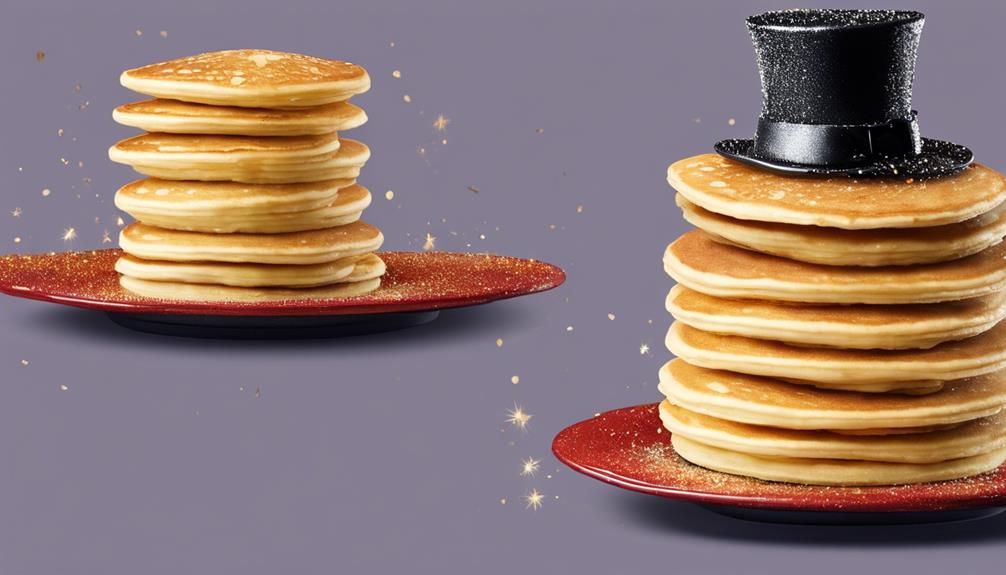
Delving into the whimsical contrasts between hotcakes and pancakes reveals intriguing distinctions that extend beyond mere culinary preferences. When comparing hotcakes and pancakes, there are some quirky evaluations to contemplate:
- Cultural Perceptions: Hotcakes are often associated with quick sales and snacks, while pancakes have a broader culinary connotation.
- Marketing Appeal: McDonald's uses the term 'hotcakes' on their menu, creating a unique marketing draw that differs from traditional pancakes.
- Japanese Distinctions: In Japan, pancakes are seen as less sweet and suitable for meals, while hotcakes are sweeter, fluffier, and considered a snack.
- Mix Differences: Hotcake mixes tend to be sweeter and fluffier, ideal for desserts, showcasing a clear distinction from pancake mixes.
- Global Variances: Cultural influences around the world shape how 'pancakes' and 'hotcakes' are perceived and used globally, highlighting the diversity in these terms.
Exploring these quirky evaluations can offer a deeper understanding of the nuanced differences between hotcakes and pancakes.
Notable Achievements
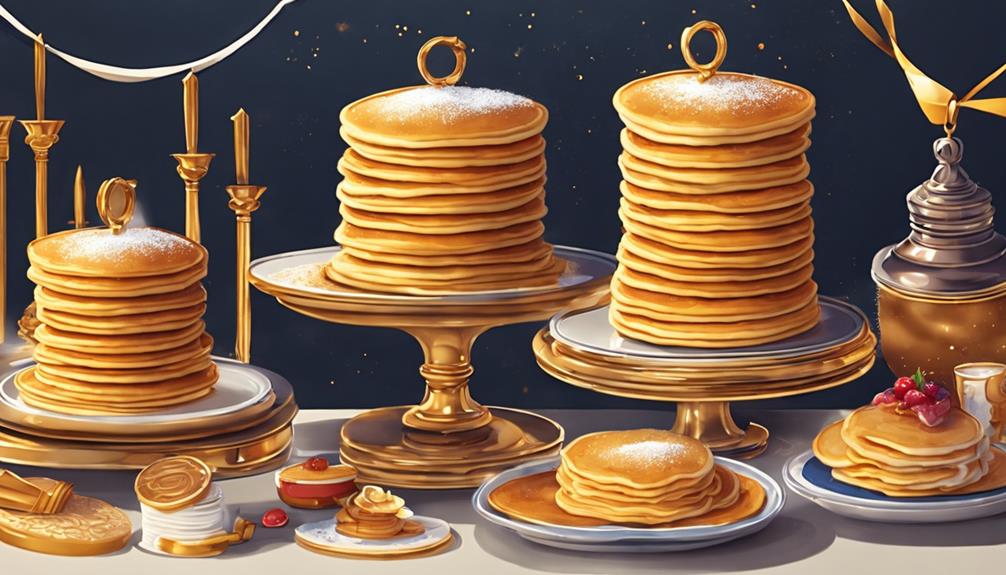
Pancakes have garnered notable achievements throughout history, showcasing their versatility and cultural significance. Did you know that the largest pancake ever made was created in Manchester, England, in 1994? This massive pancake measured over 49 feet in diameter and weighed a whopping 6614 pounds!
In 2014, a luxurious pancake was crafted at Radisson Blu Edwardian Hotels Opus One restaurant in Manchester, costing a staggering £800. It featured extravagant ingredients like lobster, caviar, and Dom Perignon champagne.
Moreover, pancake-flipping records have been set by individuals like Dominic Mike Cuzzacrea, who flipped pancakes while running a marathon, achieving records for marathon flipping and pancake tossing. Additionally, the tradition of Pancake Day, celebrated on Shrove Tuesday before Lent, involves making batches of pancakes to use up sugar, fats, and eggs before the fasting period.
Ingredients and Recipes
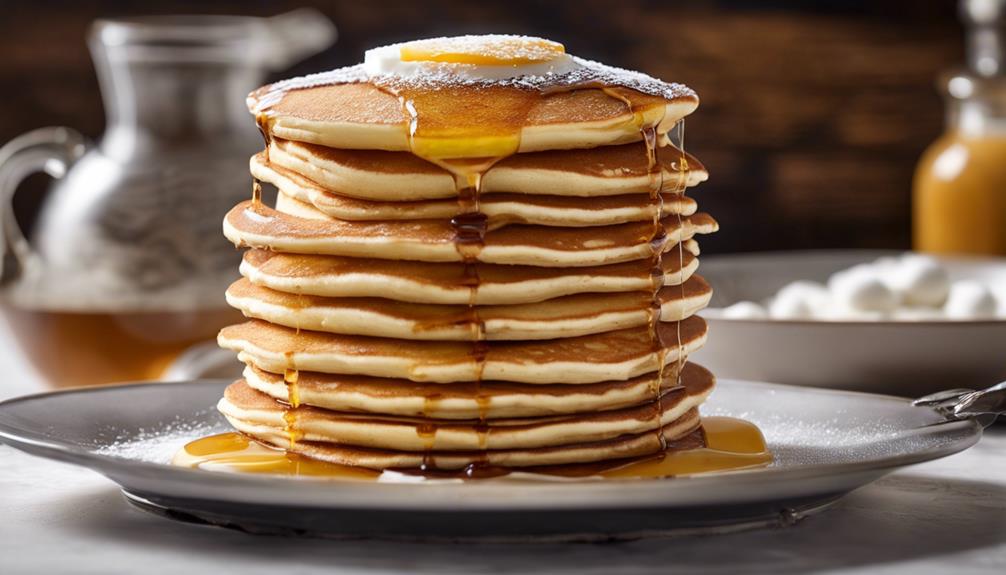
When crafting a delectable stack of hot cakes, the key lies in selecting the perfect combination of ingredients to achieve a fluffy and flavorful outcome. Hotcakes differ from traditional pancakes by often incorporating buttermilk and beaten egg whites, resulting in a thicker and fluffier texture.
To enhance the fluffiness of your pancakes, consider adding optional ingredients like buttermilk and beaten egg whites. Whole wheat pancakes offer a nuttier flavor and additional nutritional benefits compared to their traditional counterparts.
When cooking, don't forget to use a frying pan and adjust the thickness of the batter to control the fluffiness of your hot cakes. Once your hot cakes are ready, top them with maple syrup or even a scoop of ice cream for a delightful treat.
Enjoy experimenting with different recipes to find your perfect stack of hot cakes!
Regional Varieties
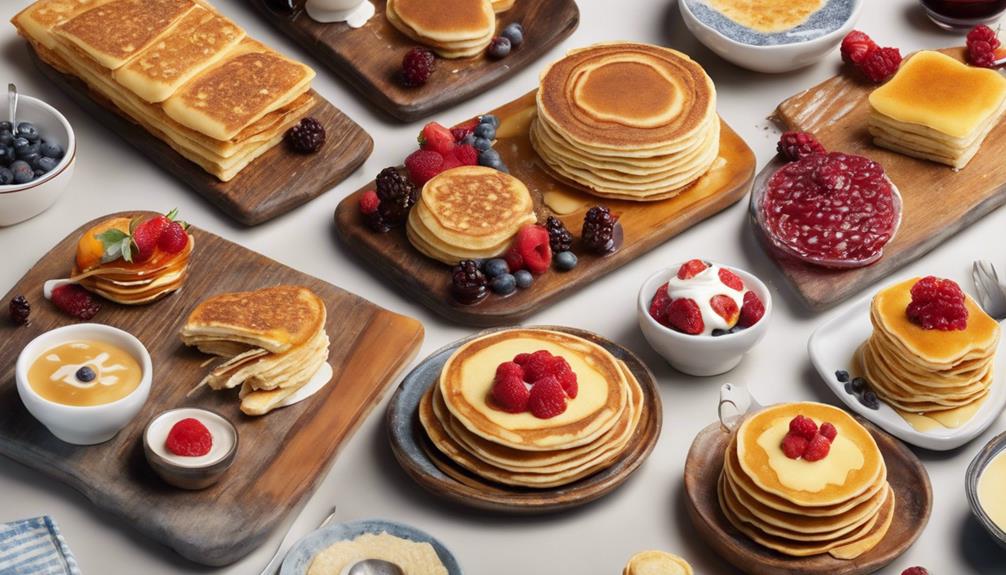
When it comes to pancakes, different regions have their own unique styles and flavors. Global pancake variations and traditional hot cake recipes showcase the rich diversity of culinary traditions worldwide.
Exploring these regional specialties can open up a world of new and exciting pancake experiences.
Global Pancake Styles
Exploring the global landscape of pancake styles reveals a rich tapestry of culinary traditions and regional variations. From European countries with their diverse pancake styles to unique variations like French crepes and Japanese okonomiyaki, pancakes are enjoyed worldwide. Here are some fascinating insights into global pancake styles:
- European countries boast a variety of pancake styles using ingredients like wheat, buckwheat, alcohol, herbs, and spices.
- Friesland, Netherlands, is renowned for its traditional wedding pannenkoek pancakes.
- Different regions showcase unique pancake variations such as the delicate French crepes and the savory Japanese okonomiyaki.
- Pancake recipes vary globally, reflecting cultural influences and ingredient availability.
- Pancake traditions, like Pancake Day before Lent, are celebrated with diverse customs around the world.
Traditional Hot Cake Variations
Indulging in traditional hot cake variations from different regions introduces a delightful journey through diverse flavors and textures. Buttermilk pancakes stand out for their tangy taste and fluffy consistency, while cornmeal hotcakes offer a nutty flavor with a slightly gritty texture.
Toppings play an essential role in enhancing the hot cake experience; from classic choices like butter and maple syrup to more daring options such as bacon, cheese, or fruit compote. Exploring toppings like fresh fruit, chocolate sauce, nuts, or even a fried egg can elevate the enjoyment of hotcakes.
Various regions boast unique hot cake variations like Indonesian serabi and Dutch poffertjes, enriching the culinary landscape with their distinct flavors and preparations.
Cooking Techniques
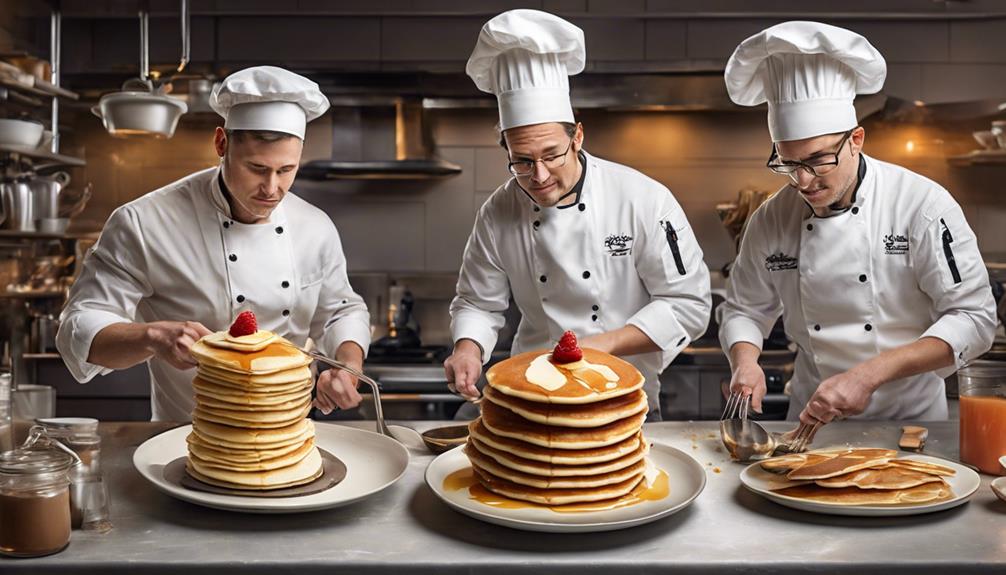
To achieve perfectly cooked pancakes, mastering the appropriate cooking techniques is vital. When it comes to cooking hotcakes and pancakes, here are some important tips to keep in mind:
- Cooking Surface: Make sure to use a griddle or skillet over medium heat for even cooking.
- Batter Consistency: Avoid over-mixing the pancake batter to maintain a light and fluffy texture.
- Tools of the Trade: Follow recipe instructions and utilize tools like a whisk and spatula for successful pancake making.
- Golden Brown Finish: Cook the pancakes until they achieve a golden brown color on both sides to ensure they're fully cooked.
- Techniques Matter: Experiment with gentle flipping and adjusting heat levels to influence the final texture and taste of your pancakes.
Frequently Asked Questions
What Is the Difference Between a Hot Cake and a Pancake?
Hot cakes are generally thicker and fluffier compared to regular pancakes. The term 'hot cake' is commonly used in the US and UK. 'Pancake' is more widely recognized. Differences may seem minor but impact culinary discussions.
What Is the Difference Between Cake and Pancake?
Pancakes are like fluffy clouds for breakfast, while cakes are decadent delights for celebrations. Pancakes are quick to make on a griddle, served with syrup, but cakes are baked, frosted, and adorned for special occasions.
What Factors Should Be Considered When Mixing Ingredients for Your Pancake?
When mixing ingredients for pancakes, I focus on proper measurements for ideal consistency. I also avoid over-mixing to keep them tender. Buttermilk adds flavor and fluffiness, while beaten egg whites create a delicate crumb.
What Are the Characteristics of Hot Cake?
When it comes to hot cakes, think fluffy, browned goodness. With a touch of sweetness, they're more than just a snack. The unique batter-beating technique creates their distinct fluffiness, making them a premium treat.
What are the Differences Between Hot Cakes and Pancakes?
Hot cakes and pancakes are often used interchangeably, but there are subtle differences. Hot cakes are typically thicker and fluffier, made with a leavening agent like baking powder. Pancakes are thinner and denser, made without a leavening agent. The hot cakes analysis and review shows that both are delicious breakfast options with slight variations.
Conclusion
To sum up, when it comes to choosing between hot cakes and pancakes, it all comes down to personal preference.
Both have their own unique history, variations, and cooking techniques.
Whether you prefer the fluffy texture of hot cakes or the thin and crispy edges of pancakes, the choice is yours to make.
Remember, the proof is in the pudding, so don't be afraid to try out different recipes and see which one flips your lid!

